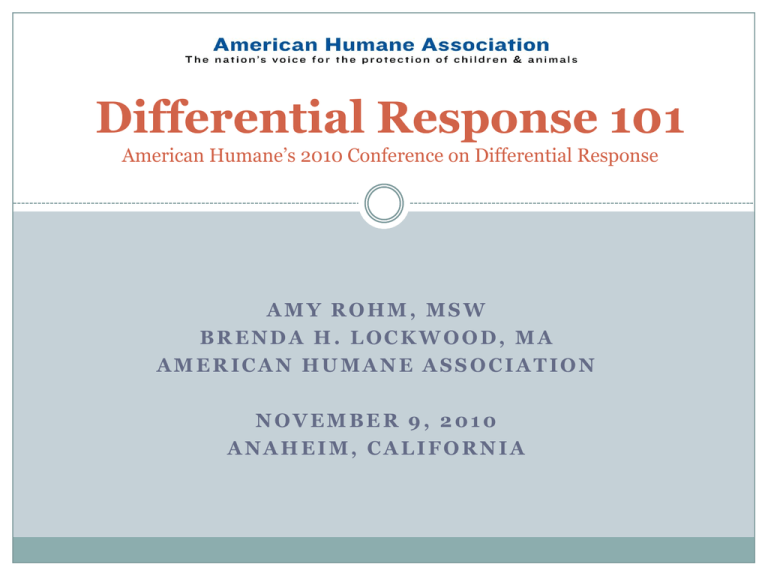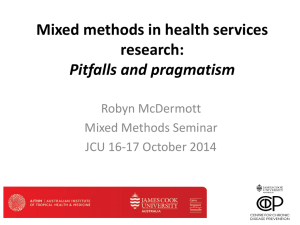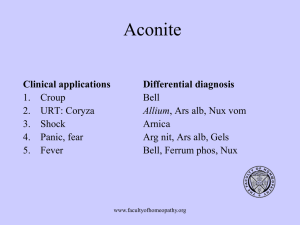Differential Response 101 - American Humane Association
advertisement

Differential Response 101 American Humane’s 2010 Conference on Differential Response AMY ROHM, MSW BRENDA H. LOCKWOOD, MA AMERICAN HUMANE ASSOCIATION NOVEMBER 9, 2010 ANAHEIM, CALIFORNIA American Humane Association’s Involvement in Differential Response Publications Annual Conference Training/Technical Assistance/Consultation Bureau of Indian Affairs California Colorado Illinois Montana New York Ohio Saginaw Chippewa Tribe (MI) Wisconsin Disseminate Information Lead for National Quality Improvement Center on Differential Response 2 Goals for this Session Provide an overview of differential response, including history, values and practice elements Share current research & evaluation on differential response Answer your questions and provide you with resources 3 What is Differential Response? Focuses less on investigative Alternative to traditional fact finding and more on assessing and ensuring child safety child protection investigative response and one of several responses within a differential response system Seeks safety through family engagement and collaborative partnerships Sets aside fault finding and substantiation decision Allows and encourages agencies to provide services without formal determination of abuse or neglect Usually applied to reports that do not allege serious and imminent harm 4 Murky Waters: What makes it so difficult to understand ‘Differential Response’ Different terminology Different definitions Different models Different services Different service providers Continuous evolution of the practice 5 History of Child Welfare and the Purpose of Differential Response 6 Purposes of Differential Response and Child Protection CPS was established to respond to all reports of suspected child maltreatment, but numbers overwhelm available resources Systems either screen out or do not open for services more than half of reports, yet many children are vulnerable 7 Purposes of Differential Response in Child Welfare Traditional investigatory practice is often adversarial & alienates parents DR is a way to respond to more reports (screened in) at an earlier stage by engaging families in a nonadversarial process of linking them to needed services 8 Why Implement Differential Response? 9 Why Implement Differential Response? Recent Study on CP Investigations : “Child Protective Services Has Outlived Its Usefulness” Do little to reduce risk Dr. Kristine Campbell, Assistant Professor of Pediatrics at the University of Utah Do not result in long- term improvement in family functioning or child behavior Published in The Archives of Pediatrics and Adolescent Medicine Oct. 2010 Are associated with increased depression among mothers 10 Why Implement Differential Response? “A lot of times the [family] situation calls for the formation of a healing relationship so the very act of going there in an investigatory mode impairs the ability [for workers] to form a meaningful relationship in which parents can be open, ask for and get help” ~Dr. Bruce Perry, M.D., Ph. D Senior Fellow Child Trauma Academy www.childtrauma.org 11 Why Implement Differential Response? Increasingly, concerned citizens and organizations are realizing that the best way to prevent child abuse is to help parents develop the skills and identify the resources they need to understand and meet their children's needs and protect them from harm 12 Why Implement Differential Response? According to National Study of Child Protective Services Systems and Reform Efforts (2003), 20 states identified one of 3 purposes as reason for DR system: child safety (55%) family preservation or strengthening (45%) prevention of CA/N (20%) 13 The Core Elements of Differential Response 14 Core Elements of Differential Response 1. 2. 3. 4. Use of two or more discrete responses to reports of maltreatment that are screened in and accepted Assignment to response pathways determined by an array of factors Original response assignments can be changed Ability of families who receive a non-investigatory response to accept or refuse to participate in differential response or to choose the traditional investigatory response 15 Core Elements of Differential Response 5. 6. 7. 8. 16 Establishment of discrete responses codified in statute, policy, protocols After assessment, services are voluntary for families who receive a noninvestigatory response (as long as child safety is not compromised) No substantiation of alleged maltreatment and services are offered without formal determination that child maltreatment has occurred Use of central registry is dependent upon type of response Differential Response in the U.S. 17 Principles and Assumptions of Differential Response 18 Principles and Assumptions of Differential Response The circumstances and needs of families differ and so should the response The majority of reports do not need an adversarial approach or court-ordered interventions Absent an investigation: child safety will not be jeopardized services can be in place more quickly families will be more motivated to use services 19 Principles and Assumptions of Differential Response Effective assessment tools Only cases of greater can be put in place to assure safety and an informed response severity need to be on state central registry Cases are monitored Frontline staff in CPS and sufficiently to change course/paths when situation requires other agencies are trained in strength based and collaborative interventions 20 Practice Framework and Assumptions The primary goal of non Families are more than investigative approach is child safety the presenting concerns Family protective factors Most families want to can assist in keeping children safe address threats to child safety Families are helped Most families can be through connections with community services and resources partners in achieving child safety 21 Comparing Traditional Child Protection Models and Differential Response 22 Traditional Child Protection Practice Model Report screened to determine appropriateness of child welfare agency intervention Investigation model is rooted in the determination of whether: Investigation (Is this a Child in Need of Protective Services?) 1. Safety and Risk Assessments 2. Gathering of Evidence A child has been harmed Disposition Re. Child in Need of Protective Services A child is at risk of being Unsubstantiated harmed Category IV Voluntary services recommended An individual is culpable Category V No services are needed for this conduct. 23 Substantiated Category I Removal required Category II Court mandated services required Category III Services are needed Model for Differential Response Report screened to determine appropriateness of child welfare agency intervention No Yes Alternative Response Screening Report is screened out. 1. Is there an administrative rule requiring that the report be investigated? Referral for other community services may be made. 2. Are there other factors that would necessitate an investigation? Family Assessment 1. Safety and Risk Assessments No 2. Complete assessment of family strengths, needs and resources. Assessment Outcome No Services No services needed Voluntary Services Recommended Family declines services Family and agency agree upon services Yes Investigation (Is this a Child in Need of Protective Services?) 1. Safety and Risk Assessments 2. Gathering of Evidence Family declines needed services Services are Needed Agency assesses that services are needed to maintain child safely at home. Family accepts needed services Disposition Re. Child in Need of Protective Services Unsubstantiated Category IV Voluntary services recommended Category V No services are needed 24 Substantiated Category I Removal required Category II Court mandated services required Category III Services are needed Differential Response System focusing on a child in need of protective services and support and engagement of the family. Commonalities of Differential Response and Traditional Pathways Focus on establishing safety not blame Safety through engagement of family strengths and community resources Parent as partner using collaborative practices Non-judgmental, honest & attentive responses Child safety addressed within context of family well-being Services not surveillance [Loman, 2005] 25 Factors Determining Response Statutory limitations Severity of the allegation History of past reports Ability to assure the safety of the child Willingness and capacity of the parents to participate in services 26 Differential Response and Child Welfare Casework Practice 27 Differential Response and Casework Practice Building Safety Around Children Protecting Children From Harm 28 Differential Response and Casework Practice Move from agency expert Focus on securing child driven compliance approach to safety focused partnership with families and communities safety through family engagement Recognizing and applying family and community strengths and resources; honoring family wisdom about their circumstances, strengths and needs, as well as culture 29 Differential Response and Casework Practice Engagement practices: Communicate with families strategically Avoid drop in visits Ask parental permission to see children Stay separate from law enforcement Be transparent in purpose & process Honor family decisions unless they compromise safety 30 31 Differential Response Research and Evaluation 32 Research Designs Missouri Family Assessment and Response (FA): Comparative study Minnesota Family Assessment Response (FAR): Random assignment Ohio Alternative Response (AR): Random assignment 33 Random Assignment Screened out Child Maltreatment Reports A Inappropriate for DR TR Traditional Investigations Initial Screening For CPS The Evaluation Control Group B Accepted Report D DR Pathway Assignment (Screened in) DR-appropriate C Pool of Reports Eligible for DR Random Assignment Control Cases E Outcome/Impact Analysis Experimental Group Cases offered DR DR Family Assessments 34 Differential Response Evaluation Child safety not diminished Missouri [began implementation 1995] Family engagement under DR CPS staff reacted positively Services to families and children increased and changed New CA/N reports and later placements of children reduced Short-term costs greater, long-term costs reduced 35 DR Evaluation: Family Satisfaction When asked if parents felt more able to care for their children now than at the time of last contact, the percentage of experimental parents replied increased from 42% to 62%. The percentage of control parents responding in the positive decreased from 49% to 42% Minnesota (More than 10 years DR Experience) On an overall satisfaction scale of 1-24, families that received FAR services scored 19.3 as compared to 17.4 for control families 36 DR Evaluation: Family Satisfaction Ohio Nearly half (47.5%) of the alternative response families said they were very satisfied with services received or offered, compared with 34.4% of control families In answering the question, “If you received some help or services,0 was it the kind you needed?,” 56.2% of the experimental families answered affirmatively compared to 46.4% of control families [10 pilots launched July 1, 2008, 10 additional counties October 2010] 37 DR Evaluation: Level of Involvement in Decision Making (MO) 100 90 80 70 60 50 Family Assessment 40 Traditional Response 30 20 10 0 Great Deal Some Level 38 DR Evaluation: Family Cooperativeness 100 90 80 70 60 Minnesota 50 Missouri 40 Ohio 30 20 10 0 More likely to be cooperative than traditional response families 39 DR Evaluation: Services Provided Missouri: Over 60% of supervisors and administrators said that DR had given their workers greater flexibility, had improved their effectiveness and increased the appropriateness of services provided to families and children 45% thought children and/or families probably had been given services or assistance because of DR that they would not have otherwise received Minnesota: Among families that received services, the mean number of services received was 1.6 for DR versus 0.9 for control families Ohio: DR workers directly assisted with 83.3% of DR families for services in the category “help with rent or house payments” compared to 30.0% for traditional response workers Similar differences were found for other related categories, such as basic household needs and emergency food 40 DR Evaluation: Percentage of Families Receiving Concrete Services 90 80 70 60 50 AR 40 TR 30 20 10 0 Ohio Minnesota 41 DR Evaluation: Child Abuse and Neglect Report Recurrence Missouri 60.7% of demonstration families had a new FCS case opened during the five-year follow-up period compared to 75.7 % of comparison families Minnesota 39.8% of control families had received one or more CPS report in the follow-up period vs. 37.5% of experimental families Researchers calculated the risk of child removal under investigation versus DR to be 28% higher, when controlling for length of time to follow-up and past CPS reports Ohio Among families entering the study during the first 360 days, 13.3% of control families had a new report compared to 11.2% of experimental families 42 DR Evaluation Subsequent Foster Care Placement/Home Removal Missouri 28.2% of demonstration families had one or more children subsequently placed versus 25.7% of comparison families Minnesota Researches calculated the relative risk of a child being placed out-of-home of the median follow-up period of 3.6 years as being twice as likely for control families Ohio Within the control group 3.7% of children had been removed while 1.8% had been removed in the experimental group, a statistically significant difference 43 DR Evaluation: Cost Analysis Missouri A goal of the DR demonstration was to make it cost-neutral to the traditional system; thus, no additional funds were made available or tracked for implementation of the pilot Minnesota Experimental average cost per family $3,688 vs. $4,968 for control families Total cost savings for DR is $1,280 – or 35% Ohio Combining direct and indirect costs for the entire period from initial report through the follow‐up on each family, mean costs of $1,325 were found for experimental cases under AR compared to $1,233 for control families in traditional investigations 44 Questions? 45 Resources American Humane Association www.americanhumane.org/differential Quality Improvement Center on Differential Response www.DifferentialResponseQIC.org Institute of Applied Research www.iartstl.org Resource Table at Conference 46 Presenter Contact Information Amy Rohm, MSW American Humane Association amyr@americanhumane.org Brenda H. Lockwood, MA American Humane Association brenda.lockwood@americanhumane.org Phone: 612-886-1183 Phone: 303-925-9413 47 References Loman, A., Filonow, C., & Siegel, G. (2010). Ohio alternative response evaluation: Final report www.americanhumane.org/assets/docs/protecting-children/PC-DR-Ohio-Section2-FinalEvaluation-Report.pdf Loman, A., & Siegel, G. (2004a). Differential response in Missouri after five years. St. Louis, MO: Institute of Applied Research. www.iarstl.org/papers/MODiffResp2004a.pdf Loman, A., & Siegel, G. (2004b). Minnesota Alternative Response Evaluation: Final Report. St. Louis, MO: Institute of Applied Research. www.iarstl.org/papers/ARFinalEvaluationReport.pdf Loman A., & Siegel, G. (2005). Alternative response in Minnesota: Findings of the program evaluation in Differential Response in Child Welfare. Protecting Children, 20(2&3), 7892. www.iarstl.org/papers/ARinMNfromProtectingChildren.pdf Siegel, G., & Loman, A. (2000). The Missouri Family Assessment and Response Demonstration impact evaluation: Digest of findings and conclusions (Updated). St. Louis, MO: Institute of Applied Research. www.iarstl.org/papers/MoFamAssess.pdf 48








